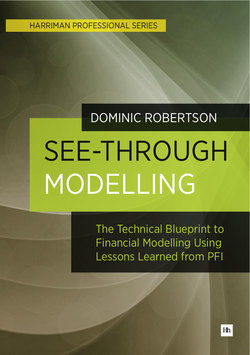Читать книгу See-Through Modelling - Dominic Robertson - Страница 50
На сайте Литреса книга снята с продажи.
Business components
ОглавлениеAs discussed, the business is made up of a series of chunks of logic called components that divide into two classes: business components and modelling components.
Here I discuss each of the components in detail.
The London Interbank Offered Rate often forms part of the basis for the variable interest rate on debt. The most frequently used LIBOR is 3-month or 6-month. If required, the model will need to have an actuals plus forecast LIBOR strip across the timeline of the model.
The macroeconomics component should contain all calculations relating to the calculation of indices such as RPI and RPIX.
The operating revenues component deals with all revenues both on an accrued and a cash basis and therefore also the working capital implications of the delay between the accrued and the cash. This can become quite a large component, depending on the type and complexity of the company. Included in this component are:
revenues accrued and received
debtor balance calculations.
The operating costs component deals with all costs both on an accrued and a cash basis and therefore also the working capital implications of the delay between the accrued and the cash. This can become quite a large component, depending on the type and complexity of the company. Included in this component are:
operating costs accrued and paid
creditor balance calculations
any prepayments and the prepayments balance.
The capital expenditure component deals with all capital expenditure both on an accrued and a cash basis. Normally for a project in operations this has all happened during the construction phase so this component should be empty.
However, for completeness the items included in this component would be:
capital expenditure accrued and paid (excluding any depreciation calculations)
creditor balance calculations relating to any assumed or known delay between the accrued expenditure and the paid expenditure.
The life cycle expenditure component deals with all life cycle costs both on an accrued and a cash basis, and therefore also the working capital implications of the delay between the accrued and the cash. Included in this component are:
life cycle expenditure accrued and paid (excluding any depreciation calculations)
creditor balance calculations relating to any assumed or known delay between the accrued expenditure and the paid expenditure.
In the accounting component I deal with all depreciation and amortisation issues that affect the P&L. In particular, these items are:
depreciation of all assets for accounting purposes
amortisation of all fees for accounting purposes.
If the project assets are accounted for by using the finance debtor accounting treatment then this component will contain calculations of:
finance debtor balance
finance debtor balance amortisation
unitary charge control account balance.
The finance component contains all funding items, non-trading income and high level statement calculations. In particular the items contained are:
equity and dividends
subordinated debt, repayments and interest
mezzanine debt, repayments and interest
senior debt, repayments and interest
interest earned and received on reserves and cash balances
retained earnings balance with net profit in period as a counter flow from the financial statements
retained cash balance with net cash in period as a counter flow from the financial statements.
The tax component deals with all government tax issues. In particular:
VAT or equivalent
tax depreciation (writing down allowances for assets allowed for tax purposes)
corporation tax accrued and paid
tax loss balance.
The financial statements are the P&L, the CFW and the BS.
The actual management accounts are made up of a series of actuals that have happened and are fixed and logged. It may be that at some point in the future changes are made but these are rare. For this book, the actual management accounts are made up of:
P&L actuals to date
CF actuals to date
BS actuals to date
tax loss balance at last actual date
written down allowance balance for all assets at last actual date
at cost value of all asset classes (we call this the basis balance) for depreciation calculations.
The analysis component deals with all calculations and results that use the financial statements as a source for the data. This component includes calculations carried out with an alternative point of view to that of the company, such as shareholder returns. In particular, the items here are:
shareholder returns
present values of shareholder cash flows
company project return
present value of company cash flows
banking cover ratios such as ADSCR, PLCR and LLCR.
